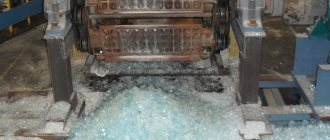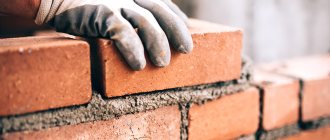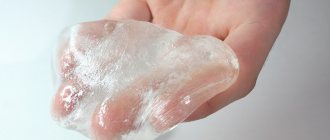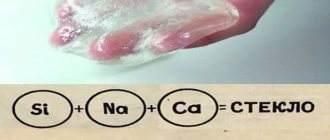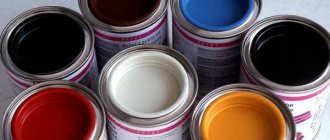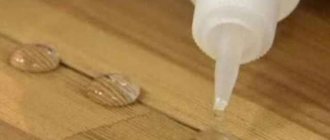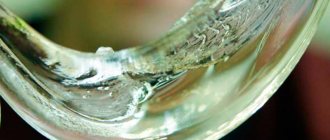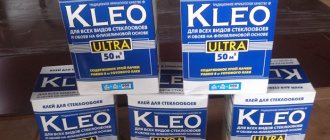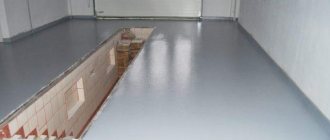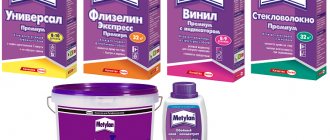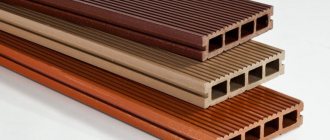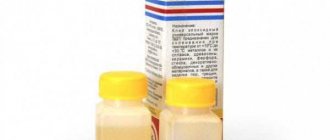Silicate office glue is a liquid substance with a lot of useful properties. This substance is also known as liquid glass in the industrial and construction sectors. Office adhesives produced on the basis of silicates are sold in office supply departments as “paper” or office composition. The scope of its application is extensive, despite the simple formula and available raw materials. However, this does not negate use according to instructions in compliance with basic safety rules.
Glue Features
From school, many people know silicate stationery glue - a viscous viscous substance that resembles a gel at the crystallization stage. In industry and construction, the substance is often called “liquid glass”, in fact, that’s what it is. The improved sodium silicate formula is a necessary component in some processes in the chemical, foundry and metallurgical industries.
Everyone knows what office glue is. This is an affordable means for gluing (fastening) smooth surfaces made of different materials. The most common use of this simple mineral compound is for gluing sheets of paper and thin cardboard.
Modern Officespace adhesive is widely known in office practice, but it can be used much wider than stationery. The fluid substance has been widely used for almost 200 years, and during this time various uses have been found for it.
The most common use of this simple mineral compound is for gluing sheets of paper and thin cardboard.
Peculiarities
Silicate liquid glass glue usually has a transparent, dense consistency, sometimes with a yellowish or greenish tint. The sodium composition of the glue ensures good adhesion of the substance to any materials. It is used when working with foundations, glass, porcelain, and is used in fireproof processing of building materials.
Potassium glue is resistant to aggressive environmental factors and is used for the production of protective paints and varnishes. It lies on the surface in the form of a matte layer without glare.
Silicate glue is produced in accordance with GOST 13078-81, so to avoid purchasing counterfeits, you can ask the seller for a quality certificate. In its pure form, liquid glass can harden in 10 minutes. If it acts as an ingredient for another building mixture, then the curing time will vary.
If you mix sodium silicate adhesive with cement-sand compositions, the hardening speed will be increased. Therefore, such combinations are often used when working with foundations and to create waterproofing coatings. Stationery glue has a special composition that allows it to quickly penetrate the structure of solid materials, releasing moisture and increasing viscosity and density.
Application area
Construction is one of the areas where sodium silicate mixture is widely used. It is considered a recyclable production waste, so silicate office glue has a low cost. This “slag”, obtained in non-ferrous and ferrous metallurgy, can be poured under the foundation when building structures begin to partially sag.
The properties of liquid glass are good protection of structures from the destruction of groundwater. This is used for waterproofing floors, swimming pool tanks, cellars and basements. Slag mixed with sodium silicate significantly extends the service life of unpaved roads.
It is important that inexpensive, high-strength material is obtained during the beneficiation of minerals; it is found in the ash of state district power plants and thermal power plants. When a substance is added to concrete, its cost (electricity costs for processing raw materials) is reduced. Silicate glue is necessary in industry - it is the basis for the delicate connection of textiles, cellulose and porous cardboard.
In metallurgy, sodium silicate is a viscous medium for spraying welding electrodes and rods and foundry molds. The foamed substance conducts heat poorly. Thermal insulation based on silicates tolerates temperature fluctuations within +1300 ° C, overheating and sudden cooling.
The heat-saving property of silicates has found application in the production of materials used in industrial devices. Its irreplaceable qualities are used in the production of products that protect against overheating (for fire safety).
In construction, this substance guarantees safety. Fireproof plaster mixtures with high moisture resistance and corrosion resistance are produced with the addition of liquid glass. It is an acid-resistant coating - an important quality in chemical production.
In construction, this substance guarantees safety.
Production technologies
In the industrial production of liquid glass, two types of technological solutions are used - dry and wet.
Dry technology
Three methods are used to obtain the finished product, depending on the main raw material: sand, silicon raw materials or cullet.
Sand based. When technical soda is added to sand, sodium is obtained, and with potash, potassium liquid glass is obtained. The content of the process is that at a temperature of about 1300 °C the mixture is baked, which, when cooled, turns into stone-like blocks of silicate.
Sodium silicate after cooling (dry technology)
What the cooled sodium mixture looks like after baking can be seen in photo 1.
Subsequently, the lumps are ground into powder and packed in paper bags.
Another option is to dissolve the crushed blocks in hot water under pressure to obtain a liquid suspension. Liquid glass is poured into plastic cans or metal barrels.
Based on silicon raw materials. The raw materials are crushed, an alkaline element (oxides of sodium, or potassium, or lithium) is added to it. The resulting mixture is mixed in a stationary or rotating autoclave at a temperature of about 1000 °C under a pressure of 3–4 atmospheres until silicate blocks are obtained. Lumps are the main material for obtaining powder or finished liquid glass.
Based on cullet. The raw materials are crushed, cleaned of impurities, an alkaline ingredient is added and the mixture is melted. After cooling, the melt takes the form of a silicate block, from which powder, granules or aqueous dispersion are obtained. From powder and granules, liquid glass can be produced on site.
Wet technology
The advantage of this type of technology is the direct production of liquid glass without first creating a silicate block.
The essence of the technology is the dissolution of raw materials containing silicon with solutions of alkaline substances. The raw materials include natural silica, most often infusorite or diatomite, in the amorphous state - in the form of powder. A concentrated alkaline solution of sodium, potassium or lithium is added to the silica, which accelerates the dissolution reaction.
The time required to obtain liquid glass depends on the size of the powder grains, temperature and pressure during dissolution. With a specific gravity of an alkaline solution of 1.2 under a pressure of three atmospheres at a temperature of about 100 °C, liquid glass from infusorite was obtained in three hours with a silicate modulus of about 3.0.
Types of stationery glue
Office or stationery glue Attache - one easy movement, and there is a perfect result. The purity of gluing is ensured by its consistency and convenient form of supply of the adhesive composition.
Office glue is produced in the following forms:
- Liquid PVA in a bottle with a narrow spout;
- Stationery glue stick;
- Liquid silicate composition.
There are several forms of release of office glue to make it as simple or easy to use as possible without getting your hands dirty. When gluing different types of paper and cardboard with a hard “pencil,” simplicity and precision in linear application are highly valued. Many people cannot imagine their work without Office glue, since they have to sort and fasten a lot of sheets of office paper.
Solid varieties are characterized by quick drying, no residue and a long shelf life. It gets dirty less and does not freeze when temperatures change, which is important for schoolchildren in winter. Its traces can be easily washed off under running water. PVA glue also washes off well, forming a polymer “skin.” In an open bottle it quickly hardens and dries out.
The purity of gluing is ensured by its consistency and convenient form of supply of the adhesive composition.
How to glue metal
Glue for lining a stove/fireplace, if you have enough time, have hands that are not afraid of work and do not have free currency, at worst you can prepare it yourself, see below. But iron stoves and fireplaces with ready-made iron fireboxes and sandwich metal chimneys are currently in use almost more than brick ones, and heat-resistant glue for alloy and glass will have to be taken.
It is much better if he also glues brick, stone, and ceramics.
The choice of furnace adhesives for the alloy, however, is not small:
- Dow Corning Q3-1566 – heat-resistant up to 350 degrees, gas-tight, does not drip from vertical surfaces. Durable at temperatures not lower than room temperature.
- Red adhesive-sealant Belife Silicone - operating temperature range of a completely dry seam from –70 to +300 degrees Celsius. You can glue with this glue at a temperature not lower than +18 Celsius.
- PENOSIL Premium +1500 – expensive, but heat-resistant foaming; Suitable for assembly and sealing of sandwich chimneys. Glues alloy, glass, ceramics and stone in all combinations.
Naturally, it is impossible to assemble an iron stove or fireplace entirely with glue, due to fire safety requirements. But it may be necessary to repair its flame part or, say, it is necessary to glue down fallen decorative parts. A strong and perhaps heat-resistant fire-resistant alloy adhesive may be useful for this. This can be electrically conductive (cold welding) or dielectric.
For a wood or coal stove, this, as they say, is deeply heartfelt from the highest place, so it gives a general summary:
- Diamond is heat resistant up to 1316 degrees. Low temperature during gluing – +18 degrees. Complete hardening time is 24 hours.
- Alteco – for external repairs of finished closed fireboxes. Heat-resistant up to 260 degrees, hardening time 22.5 hours, gluing temperature not lower than +18.
- Poxipol - the same, but with increased strength.
Temperature during gluing from +16 degrees, curing time 30 hours.
- Zollex – durable up to +260 degrees, hardens in 60 hours. Low gluing temperature +18.
Glue composition
Liquid glass was first produced experimentally in Germany. The technology for its production turned out to be simple and accessible, and the natural raw material was cheap and widespread - silica SiO2.
Bavarian Chemist Johann Nepomuk von Fuchs in 818 was able to obtain an aqueous-alkaline solution of polysilicates:
- Sodium – Na2O(SiO2)n;
- Lithium Li2O(SiO2)n;
- Potassium – K2O(SiO2)n.
Natural deposits of natural silicates necessary for the production of liquid glass are ubiquitous. They can also be synthesized artificially. The availability and prevalence of office glue is explained by its low cost and wide range of applications.
Natural deposits of natural silicates necessary for the production of liquid glass are ubiquitous.
Packaging, packaging forms
Today, even children know what silicate glue looks like, although it is difficult to do without it in other sectors of the national economy. The predominance of beneficial properties and the availability of raw materials guarantee the demand for silicate composition in modern practice. The office supply departments offer a wide selection of office adhesive in the form of tubes, bottles and sticks.
Schoolchildren should know that the thick transparent suspension should not get into the eyes or hair. However, traces of transparent stationery glue can be easily washed off after classes with running water.
The release form is designed in such a way that the gel-like liquid stains your hands as little as possible. Therefore, Office Space glue and other brands are offered in plastic bottles, in the form of rods or pencils.
Liquid silicates can be stored in a glass container with a tight-fitting lid, away from small children.
The release form is designed in such a way that the gel-like liquid stains your hands as little as possible.
Types and brands
For its intended purpose, silicate glue is used in everyday life and in industrial production. In everyday life, this glue is called stationery (less commonly, office glue). In state standards, the name adopted is liquid glass (sodium, sodium-potassium, potassium, potassium-sodium or lithium).
Office glue is sold in stores by over ten manufacturers. The main brands are BRAUBERG, Attaché, Berlingo, OfficeMag, Expopribor. These brands are produced by many countries according to a single recipe.
The basis of the suspension of all brands is sodium silicate. As a rule, glue for household needs is a fairly thick, transparent gel. Each brand uses its own type of packaging.
Liquid glass is produced by glass factories as an additional product, and some as a main product. These factories are located in places rich in minerals necessary for production - silica and alkali metals.
For industrial needs, liquid glass is produced in the form of powder, granules or aqueous suspension. Powder is a white substance. The granules and suspension may have shades of gray, yellow or greenish, depending on the alkali used.
Advantages and disadvantages
OfficeSpace stationery glue has gained popularity due to its excellent qualities:
- Lack of toxicity;
- High adhesive ability;
- Fire safety;
- Environmental friendliness;
- Ease of use;
- Availability.
Silicate compounds are used to glue not only paper and cardboard. PVA easily bonds leather, fabric, glass and plastic. However, liquid glass has a significant drawback - after a while, the adhesive strip turns yellow, the connection crumbles, and becomes brittle.
The “disadvantages” include its alkaline reaction - if an unpurified substance comes into contact with the skin, a chemical burn is possible.
Silicate compounds are used to glue not only paper and cardboard. PVA easily bonds leather, fabric, glass and plastic.
Advantages of silicate glue
The use of glue in the listed areas is due to its positive qualities. These include:
- Cheapness of the starting components for the production of liquid form.
- Easy to store at low temperatures - does not lose its properties after freezing and thawing.
- High degree of adhesion to almost any materials, determined by the value of the silicate module.
- The ability to form a durable waterproofing film with a service life of up to five years. The film protects against acids and overheating. She herself is not flammable.
- When dry, an insoluble adhesive layer appears, which has antiseptic and antistatic properties.
- When drying, there are no deformation shifts, which preserves the shape and strength of the glued materials.
| Type of glue | PVA | Liquid glass |
| Origin | Obtained artificially | Contains minerals |
| Appearance | The color is white and the consistency is creamy | Translucent, has a slight yellowish tint, the consistency is more liquid |
| Impact on paper sheet | Glues thin sheets and photographic paper. Does not turn yellow | May turn yellow over time |
| Bonding ability | Can glue lightweight parts made of glass, plastic, wood, fabric | Glues paper, cardboard |
Technical specifications
Silicate glue is an unacceptable environment for mold, rot, fungi and insect breeding.
Main technical parameters, according to GOST:
- It looks like a thick liquid mass, odorless, slightly yellowish.
- The adhesive base has no impurities, suspensions or inclusions.
- It has a high density - 1.36-1.45 g/cm3.
- The proportion of insoluble substances per total mass is within 0.2%.
- The shelf life of liquid glass glue in original containers is about 2 years.
- Freezing and thawing of the composition in containers is acceptable.
Liquid glass is an excellent moisture and heat insulator and is included in façade paints.
The adhesive base has no impurities, suspensions or inclusions.
Flaws
In addition to a large number of advantages, glue also has disadvantages, which take into account
When planning use, the disadvantages of liquid glass are also taken into account. Some of them are related to the advantages of the adhesive mass:
- The adhesive is not suitable for processing porous materials such as brick. Due to its high penetration, the suspension fills all pores and, when dry, breaks the brick from the inside. This limits the use of the suspension in construction.
- Short working time with solutions that contain silicate glue - rapid hardening requires the skills and experience of builders.
- For waterproofing, other components are needed, to which the material is used as an addition.
Using office glue at home
In construction and finishing works, liquid glass can be used to fix linoleum or carpet to the floor. It is added to compositions for fixing tiles and wallpaper, to water-based paint, primer and putty.
Everyone chooses the most comfortable form so as not to feel discomfort in daily practice. However, parents getting their children ready for school for the first time may experience difficulties due to the large assortment - PVA glue or stationery “pencil”.
Not everyone knows that office glue is often included in laundry detergent. In cellulose products, sodium silicate adds extra hardness and shine. This is noticeable in rolls of non-woven wallpaper, where the fibrous backing is much stronger than that of the tailor's "lining" material.
The silicate compound has even been used in the practice of gardeners - after pruning and grafting fruit trees, the cut site is protected. This quickly heals exposed tissue, protecting against fungal infections and parasites. It is also included in façade silicate paints and sealing putties.
It is added to compositions for fixing tiles and wallpaper, to water-based paint, primer and putty.
Specifications
Silicate glue has gained immense popularity and demand due to the following qualities:
- Versatility - can be used to perform various types of construction work.
- Creating a protective layer on the surface of any material, reliable protection.
- Reduced curing time.
- The presence of antiseptic properties, preventing the appearance of fungus and mold on materials.
- Fireproof characteristic.
- They contain no harmful substances, so they can be used even indoors.
- Long period of operation.
- Simplicity and ease of application, easily lays in an even layer on working substrates.
- Long shelf life, approximately 2 years. The quality of the composition is not affected by regular freezing and defrosting. During long-term storage, sediment may appear, which is considered quite acceptable.
- The created insulating base made of silicate glue can withstand temperatures of 1300°.
In addition to numerous positive qualities, silicate glue also has disadvantages:
- This composition contains a significant amount of alkali, so it is necessary to avoid contact of the substance with human skin. You need to carry out the work wearing rubber gloves.
- High hardening speed, within 20 minutes. The work must be carried out very quickly, since after hardening the glue is no longer suitable.
How to make glue with your own hands - instructions
There are several ways to make your own stationery glue. One method is to melt quartz sand with soda in a separate container with refractory walls.
Fans of “cheating” offer a household method:
- Mix metal silicates.
- Place a 10% acid solution.
- Dilute the substance to the desired consistency (the entire mass is covered with liquid); stirring, heat the mixture over the fire, bringing to a boil for about 10 minutes.
- Cool the glue and pour into glass jars with tight-fitting lids.
Processing of raw materials containing silica with sodium hydroxide (lithium or potassium) is used. It is important to maintain the boiling point of the alkali with which the raw materials interact.
One method is to melt quartz sand with soda in a separate container with refractory walls.
Terms of use
It is most convenient to apply transparent office glue at home with a brush, but spraying with a spray bottle is possible if cardboard or paper of a large area is impregnated.
Application:
- The adhesive composition is applied to a dry, clean, grease-free surface;
- The surface must be smooth and even;
- On a hard surface, additional impregnation, moistening or primer is sometimes needed;
- A layer of glue is applied to the dry primer without drips or dry gaps;
- If the format of the impregnated roll is small, you can apply a second layer after the first application has partially dried;
- After uniform distribution, the layers are fastened;
- Without moving the product, wait until the impregnation dries;
- Make sure that the gluing is of sufficient quality; there may be gaps in the seams, which are filled with a thin brush.
In production processes, it is permissible to dip the impregnated parts into the composition.
Even distribution of the adhesive ensures a reliable connection. Therefore, it is advisable to avoid sagging and drips that unnecessarily soak the paper - it deforms unevenly.
Adhesive-based antiseptics - dilute the primer with a silicate compound in a 1:1 ratio. The walls, ceiling or floor are impregnated with the finished mixture.
When preparing plaster or concrete for pouring the foundation, liquid glass is added no more than 25% of the volume. It is introduced into the finished sand-cement mixture.
Even distribution of the adhesive ensures a reliable connection.
Instructions for use
The procedure for using liquid glass in industry is determined by the technologies of the relevant industries. The rules determine the doses and composition of the suspension used for each product, as well as safety measures when working with it.
Each package of glue contains instructions for its use. Household tasks include gluing paper, wood, glass and metal surfaces, as well as coating various surfaces, repairing clothing and footwear. The following operating rules are recommended.
- Prepare the necessary equipment for work - cans of glue, brushes, brushes, rollers, etc. Clear the area for the location of the items to be glued, protected or repaired from foreign objects.
- Prepare the amount of liquid glass required for processing large surfaces from dry ingredients.
- Clean the bonding and repair areas from dirt and grease deposits. If you are gluing wooden and metal surfaces, remove minor defects with emery cloth.
- When gluing, apply a thin layer of glue to both surfaces, apply them with the treated sides and press. Wait until the glue crystallizes, after which the glued parts can be used for their intended purpose.
- To protect the surface from harmful effects, clean it thoroughly. Prime the wooden surface with an adhesive primer. After the primer has dried, apply the glue in thin layers (5-6 layers). Apply each subsequent layer after the previous one has dried. Apply the adhesive composition with a brush or using a spray bottle.
- Before applying protection to the car body, clean the surface from dirt, polish and degrease with appropriate reagents. Apply 3 to 10 layers of silicate glue. The drying time of the adhesive protection on the body is 8–10 hours. During this period, prevent dust from entering the body.
- When working, make sure that the glue does not come into contact with exposed skin or eyes. If this happens, wash off the glue with water, not allowing it to dry out.
How to dilute
A dense transparent sticky mass looks like jelly. A homogeneous substance according to OKPD is included in group 220.52.10 “Adhesives”, which are produced according to GOST 13078-81 standards.
Even without knowing the composition, office glue is easy to dilute if its consistency is too thick and heavy. While stirring vigorously, the mixture is gradually diluted with warm water.
It is better to remove solid clots. Excess water will not increase the volume of the glue, but will reduce its viscosity and bonding ability.
Universal extra glue is also diluted with an acetone-based solvent or acetic acid.
Office glue is easy to thin if its consistency is too thick and heavy.
Glue and its types
Man discovered and used the adhesive substance 11 thousand years ago. At first it was made from animal ingredients. Now there are effective formulations with artificial ingredients. They are safe and can be used for children's creativity.
Stationery glue, although it has one main task - to glue objects together - is presented on the market in several forms, differing in composition and appearance. What kind of glue can be found on the counter today:
- liquid,
- glue stick,
- spray,
- ribbon.
Conventionally, office glue can be divided into liquid and solid. The liquid type includes PVA and silicate glue. The solid is available in the form of a pencil roller. Among the types of products that have recently appeared on the market, adhesive web tape should be highlighted. It is used in applications for gluing fabric and leather using heating with an iron. Aerosol adhesive spray is easy to use: it is easy to apply and evenly distributed over the paper.
How and with what to wash
If children spill glue on the surface of upholstered furniture or clothing, it is advisable to immediately clean it off or wash it off with warm water. It is better to wash clothes immediately, adding spoons of soda to 2 spoons of washing powder. After 2-3 hours, the soaked stain is cleaned with a brush and finished with rinsing, like a regular wash.
To soften an old stain, you need “anti-glue”. Hardened dirt can be softened with hot water and gently scraped off the fabric with the blunt part of a knife. Acetone or refined gasoline can be used as a “solvent” for glue residue.
It is better to first check the effect of acetone on fabric on the back of the clothing - it easily removes dyes along with the stain.
It is better to wash clothes immediately, adding spoons of soda to 2 spoons of washing powder.
Adhesive manufacturers
There are not many brands of glue offered in the domestic retail chain, but they all sell products of approximately the same quality. Liquid sodium glass is also offered by the Stekloprodukt company; you can order the composition from them in large packages.
Stationery glue in small packaging:
- "Office Space";
- «;
- "Attache";
- "Berlingo".
For office workers, Erich Krause and Kores are considered the most prestigious brands. Products are produced for schoolchildren in St. Petersburg. In terms of price and quality ratio, they compete with products.
For office workers, Erich Krause and Kores are considered the most prestigious brands.
Liquid glass is a viscous substance that is part of many adhesives and building mixtures. The substance has been known to mankind for more than 200 years, but its scope of application is gradually expanding. The environmentally friendly mass is sold in convenient packaging so as not to stain your skin and clothes. In a classroom or office setting, it is better to apply it extremely carefully.
Tips and tricks
When working with liquid glue, you should be guided by the following tips and recommendations from experienced craftsmen and specialists:
- The finished surface must be perfectly flat and smooth, without flaws.
- Avoid getting glue on exposed skin.
- After completion of construction and repair work, you need to carefully close the bottles and jars of glue in order to preserve the ability to use the product another time.
- To slow down the hardening period of the solution, you need to mix the composition in a different order. First add glue to the water, and only then cement and sand.
- Apply glue only to degreased and primed surfaces to increase the level of adhesion.
- It is necessary to prevent foreign particles from entering the composition so as not to disrupt adhesion.
- It is better to prepare the glue in small portions so that you have time to work with it before it completely hardens.
- After treatment with liquid glass, it is necessary to ensure that the surface remains motionless for a certain period. It will take at least a day to dry completely.
